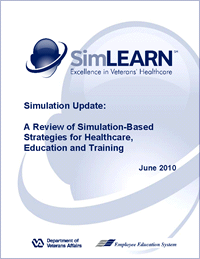SimLEARN Compendium
Compendium Designed to Support Local Learners and Learning Leaders

THE CURRENT COMPENDIUM IS UNDER REVIEW FOR UPDATES
The transition to clinical simulation training and education can seem intimidating. Yet given the right tools and resources, establishing a clinical simulation training and education program can be very doable.
To support Veteran Health Administration (VHA) medical centers with the information necessary to begin the process, SimLEARN has worked with clinical simulation experts, in and outside of the VHA, to bring you a compendium with current information on training methods using typical simulation modalities. This compendium can serve as a resource for local staff, students and educators to facilitate the transition from traditional training to the exciting and clinically relevant simulation modalities used in today's nursing and medical schools.
The compendium, titled "Simulation Update: A Review of Simulation-Based Strategies for Healthcare, Education and Training," contains articles written especially for VHA learners and covers a broad range of simulation topics, including:
- Mannequin-Based Simulation
- Standardized Patient Simulation
- Virtual Environments
- Process Modeling
- Task Trainers and Haptics
- Virtual Patient Simulations
The compendium will also be available in print and on CD-ROM. We also recommend that you work with your local librarian to ensure that clinical simulation text references and journal sources are available at your local facility to keep staff motivated and informed. A list of potential text references and journals can also be accessed at SimLEARN's Web site.
We encourage you to reach out to your local colleagues within the Department of Defense, the medical community, the affiliate and other VA medical centers to begin routine sharing of information on technologies and learning practices. Though their priorities for curriculum topics may vary from your facility's priorities, the simulation training methods used are usually transportable and adaptable across a broad range of topics.



















